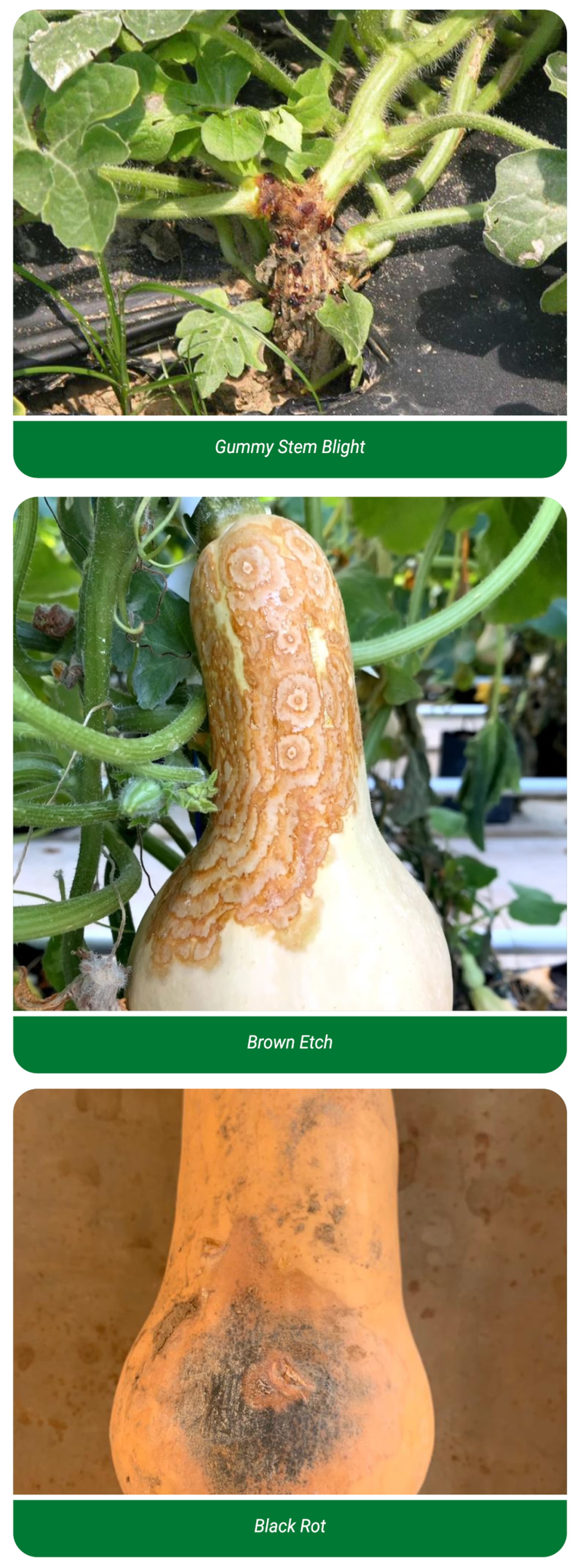Growers of butternut, pumpkin and squash are all too familiar with a disease known as gummy stem blight (GSB). The fungal pathogen, previously known as Didymella bryoniae, may cause significant yield loss on most cucurbit species. The fungus has been re-classified as a complex of Stagonosporopsis species able to cause GSB, black rot (BR) and, sometimes, brown etch (BE) on cucurbit crops.
GSB describes the symptoms on above-ground plant parts, such as leaves, vines, petioles, stems, and flowers. Cankers can form on crowns and vines, causing tissue to crack and split open, with gummy plant sap exudates giving the disease its common name. In a susceptible plant, these lesions expand to girdle the stem, leading to wilting and eventual plant death.
BR is used to describe the phase affecting mature fruit. The pathogen causes a soft rot with black discolouration of the cucurbit fruit tissue. Small water-soaked spots later develop to form large irregular lesions, accompanied by a gummy exudate. Different cucurbits may show variation in symptoms, for example, on watermelon BR appears as a large expanding rot starting at the blossom end of the fruit, while pumpkin symptoms may be mistaken for anthracnose as sunken lesions appear on the fruit.
Another type of fruit symptom observed, sometimes referred to as brown etch or rust mark, is often mistakenly associated with the GSB- and BR-causing pathogens. Symptoms appear as light tan to dark brown, superficial lesions, expanding across the surface of the fruit. It may develop as a series of concentric rings, a spreading blotch, or a marbled brown area. Over time, the etched tissue dries out, developing a whitish appearance and dark fungal structures may or may not appear on the dead tissue. Brown etch can develop from a contact point between the fruit and the soil and since symptoms are superficial, eating quality is normally unaffected but the shelf-life of fruit may be negatively impacted.
Recent research shows that these etch-like symptoms are more likely to be caused by environmental and stress factors. Consequently, it is important to differentiate between GSB and BR (that are mostly caused by Stagonosporopsis spp.) and BE (which is only sometimes caused by the pathogen, but more likely a result of abiotic stress factors). Due to the necrotic nature of brown etch tissue, the lesions are commonly colonised by fungi like Stagonosporopsis, Fusarium and several other weak pathogens which confuses diagnosis.
Black rot and GSB can be managed through crop rotation, cucurbit crop residue management and the targeted use of fungicides. Since the exact abiotic factors linked to etch development have not been determined yet, no control measures other than the planting of resistant cultivars can be recommended.
